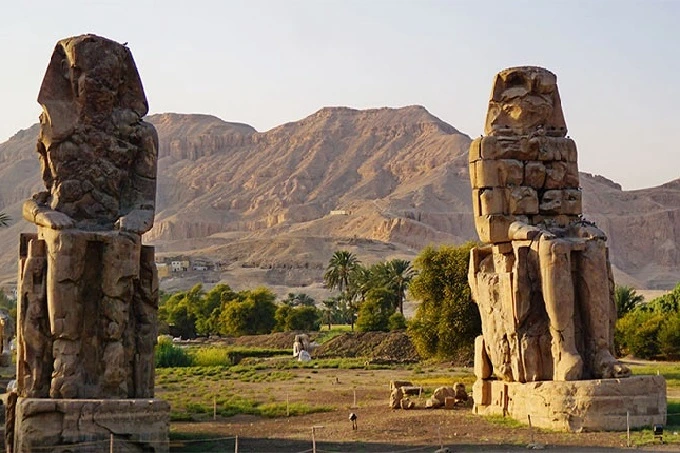The Colossi of Memnon are one of the architectural masterpieces of fabulous antiquity. These are two huge statues of the Egyptian pharaoh Amenhotep III (ruled 1388-1351 BC). Erected in 1350 BC. They were in the necropolis of Thebes – the capital of Ancient Egypt.
Colossi Memnon was located 700 km south of the Mediterranean coast on the east bank of the Nile. The necropolis itself was on the west bank. Currently, on the opposite bank from the statues is modern Luxor city.
The twin statues depict the Egyptian pharaoh in a seated position with his palms resting on his knees. The gaze of the stone figures is directed eastward toward the Great Nile. Near the feet, two figures are carved: wife Tiya and mother Mutemuia. The Nile god Hapi is depicted on the side panels.
The statues are made of blocks of recrystallized sandstone (quartzite). The blocks were cut in the quarry of Jebel el-Ahmar. This is 675 km from Thebes. They were transported by land, as no riverboat could have withstood the weight.
The height of the colossi, together with the stone platforms on which they stand, is 18 meters. They weigh 720 tons each. The statues are located at a distance of 15 meters from each other.
These unique creations of antiquity are badly damaged. The southern figure is missing one stone block. The northern figure has a crack above the waist. The upperparts are made up of different types of sandstone, the result of Roman reconstruction. It is believed that, at first, both figures were absolutely identical. Only the inscriptions on them differed.
Majestic man-made monuments guarded the entrance to the memorial temple of Amenhotep. At that distant time, this temple complex was the richest and largest in ancient Egypt. In terms of the area, it occupied 35 hectares. Nowadays, from all this splendor remained only two half-ruined stone figures.
Some historians believe the majestic statues were destroyed by an earthquake in 27 BC. The source is the statement of the historian Strabo, who wrote about it in the I century. The upper parts of the stone figures, up to the waist, fell to the ground. However, this reason for the destruction is questionable since in Egypt, there are no earthquakes.
There is another version. The Persian king Cambyses is referred to as the one who caused the destruction. He ruled in the second half of the VI century BC and was the initiator of military expansion into ancient Egypt. It is by his order the greatest architectural creations were destroyed.
This is more likely to be true, but the main thing is that after the destruction, the statues began to emit a long sound at sunrise. This was repeated day after day for centuries. Strabo, Pausanias, Philostratus, and Lucian wrote about it. So there is no reason not to believe this phenomenon.
As for the people of art, they have composed romantic legends. According to it, the “singing” twin stones represented Memnon. He was the son of Tiphon and Aurora, the king of Ethiopia. He was sent by his father to help the defenders of Troy, besieged by the Greek army. Memnon killed Antilochus, who was considered a friend of Achilles. And the latter, mad with rage and grief, stabbed his friend’s murderer.
Aurora, upon learning of her son’s death, begged Jupiter to revive her beloved boy for at least one moment a day. The mighty god took pity on the woman, and Memnon came to life every morning, accompanying his resurrection with a long, pitiful groan.
As for the scientific explanation of the phenomenon, the sound most likely came from vibrations. It was created by the porous surface of the fracture. The stones, which had cooled down during the night and soaked up moisture, were heated by the morning sunlight, and this process caused a characteristic sound effect.
The phenomenon came to an end in 199. By order of the Roman Emperor Septimius Severus the colossi of Memnon were restored. The fallen off blocks of stone were put back in place, and the majestic statues found a second life. Nowadays, an endless stream of tourists goes to them. They sincerely admire the majestic and large-scale creations of the era that fell into darkness.
